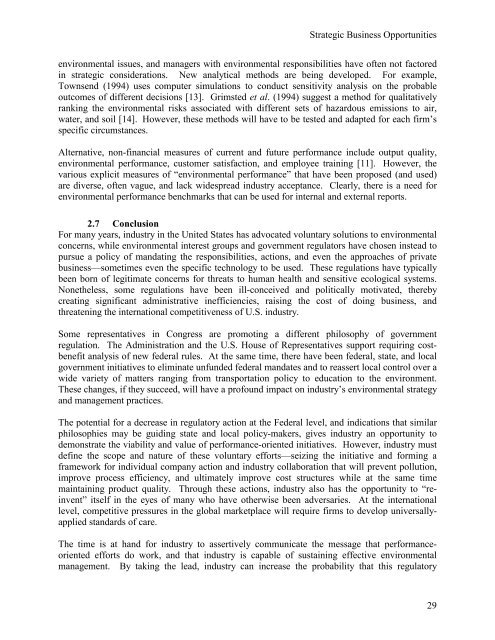1996 Electronics Industry Environmental Roadmap - Civil and ...
1996 Electronics Industry Environmental Roadmap - Civil and ...
1996 Electronics Industry Environmental Roadmap - Civil and ...
Create successful ePaper yourself
Turn your PDF publications into a flip-book with our unique Google optimized e-Paper software.
Strategic Business Opportunities<br />
environmental issues, <strong>and</strong> managers with environmental responsibilities have often not factored<br />
in strategic considerations. New analytical methods are being developed. For example,<br />
Townsend (1994) uses computer simulations to conduct sensitivity analysis on the probable<br />
outcomes of different decisions [13]. Grimsted et al. (1994) suggest a method for qualitatively<br />
ranking the environmental risks associated with different sets of hazardous emissions to air,<br />
water, <strong>and</strong> soil [14]. However, these methods will have to be tested <strong>and</strong> adapted for each firm’s<br />
specific circumstances.<br />
Alternative, non-financial measures of current <strong>and</strong> future performance include output quality,<br />
environmental performance, customer satisfaction, <strong>and</strong> employee training [11]. However, the<br />
various explicit measures of “environmental performance” that have been proposed (<strong>and</strong> used)<br />
are diverse, often vague, <strong>and</strong> lack widespread industry acceptance. Clearly, there is a need for<br />
environmental performance benchmarks that can be used for internal <strong>and</strong> external reports.<br />
2.7 Conclusion<br />
For many years, industry in the United States has advocated voluntary solutions to environmental<br />
concerns, while environmental interest groups <strong>and</strong> government regulators have chosen instead to<br />
pursue a policy of m<strong>and</strong>ating the responsibilities, actions, <strong>and</strong> even the approaches of private<br />
business—sometimes even the specific technology to be used. These regulations have typically<br />
been born of legitimate concerns for threats to human health <strong>and</strong> sensitive ecological systems.<br />
Nonetheless, some regulations have been ill-conceived <strong>and</strong> politically motivated, thereby<br />
creating significant administrative inefficiencies, raising the cost of doing business, <strong>and</strong><br />
threatening the international competitiveness of U.S. industry.<br />
Some representatives in Congress are promoting a different philosophy of government<br />
regulation. The Administration <strong>and</strong> the U.S. House of Representatives support requiring costbenefit<br />
analysis of new federal rules. At the same time, there have been federal, state, <strong>and</strong> local<br />
government initiatives to eliminate unfunded federal m<strong>and</strong>ates <strong>and</strong> to reassert local control over a<br />
wide variety of matters ranging from transportation policy to education to the environment.<br />
These changes, if they succeed, will have a profound impact on industry’s environmental strategy<br />
<strong>and</strong> management practices.<br />
The potential for a decrease in regulatory action at the Federal level, <strong>and</strong> indications that similar<br />
philosophies may be guiding state <strong>and</strong> local policy-makers, gives industry an opportunity to<br />
demonstrate the viability <strong>and</strong> value of performance-oriented initiatives. However, industry must<br />
define the scope <strong>and</strong> nature of these voluntary efforts—seizing the initiative <strong>and</strong> forming a<br />
framework for individual company action <strong>and</strong> industry collaboration that will prevent pollution,<br />
improve process efficiency, <strong>and</strong> ultimately improve cost structures while at the same time<br />
maintaining product quality. Through these actions, industry also has the opportunity to “reinvent”<br />
itself in the eyes of many who have otherwise been adversaries. At the international<br />
level, competitive pressures in the global marketplace will require firms to develop universallyapplied<br />
st<strong>and</strong>ards of care.<br />
The time is at h<strong>and</strong> for industry to assertively communicate the message that performanceoriented<br />
efforts do work, <strong>and</strong> that industry is capable of sustaining effective environmental<br />
management. By taking the lead, industry can increase the probability that this regulatory<br />
29






